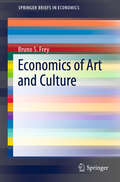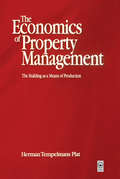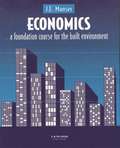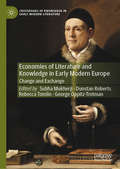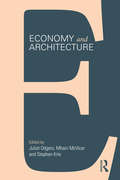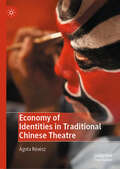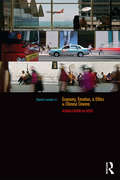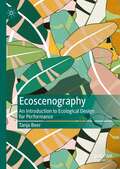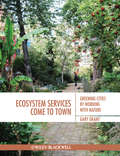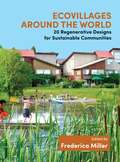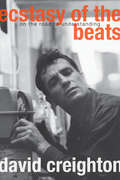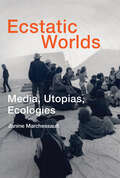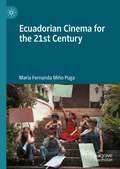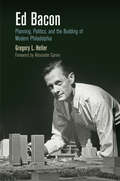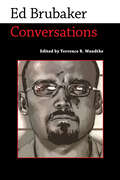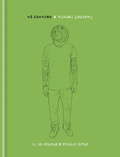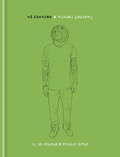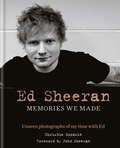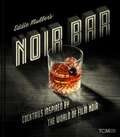- Table View
- List View
Economics of Art and Culture (SpringerBriefs in Economics)
by Bruno S. FreyThis book studies the relationship between the arts and the economy. By applying economic thinking to arts and culture, it analyses markets for art and cultural goods, highlights specific facets of art auctions and discusses determinants of the economic success of artists. The author also sheds new light on various cultural areas, such as the performing and visual arts, festivals, films, museums and cultural heritage. Lastly, the book discusses cultural policies, the role of the state in financing culture, and the relationship between the arts and happiness.
Economics of Property Management: The Building As A Means Of Production
by Herman Tempelmans Plat Frank HeynickThe economic analysis of a building is a complex subject and traditionally it has focused on a single aspect of the structure or a single part of the construction process. Dr Tempelmans Plat is a leading proponent of a new methodology which focuses on the building as a stock of services to be supplied over a long lifespan. This method is more realistic since it takes into account the changes in use and the adaptation of the building over its life. This book will be the first to make this method comprehensible to a wide audience of postgraduate students and professionals in the field of construction economics.
Economics: A Foundation Course for the Built Environment
by J.E. ManserMaking no assumption of your prior knowledge, Economics introduces the basics of economics as they relate to the built environment. Looking at the principles of microeconomics (markets, price mechanisms, resource allocation, theory of the firm, etc.), these principles are put into the context of construction firms and property markets. Lively, real-life case studies are built into the text to provide concrete examples of the theories being explained and macroeconomics are also covered. Key features of this easy-to-use book include: clear chapter structure tutorial questions linking the case histories to basic principles extracts from newspaper and journal articles to show the relevance of economics to the construction industry 100% construction orientation a useful bibliography, glossary of economic terms preview questions at the start of each chapter and exercises and discussion topics at the end to test your understanding. Economics will enable you to understand the working of economic forces as they relate to the construction industry.
Economies of Collaboration in Performance: More than the Sum of the Parts
by Dominic Symonds Karen SavageThis is a book about collaboration in the arts, which explores how working together seems to achieve more than the sum of the parts. It introduces ideas from economics to conceptualize notions of externalities, complementarity, and emergence, and playfully explores collaborative structures such as the swarm, the crowd, the flock, and the network. It uses up-to-date thinking about Wikinomics, Postcapitalism, and Biopolitics, underpinned by ideas from Foucault, Bourriaud, and Hardt and Negri. In a series of thought-provoking case studies, the authors consider creative practices in theatre, music and film. They explore work by artists such as Gob Squad, Eric Whitacre, Dries Verhoeven, Pete Wyer, and Tino Seghal, and encounter both live and online collaborative possibilities in fascinating discussions of Craigslist and crowdfunding at the Edinburgh Festival. What is revealed is that the introduction of Web 2.0 has enabled a new paradigm of artistic practice to emerge, in which participatory encounters, collaboration, and online dialogue become key creative drivers. Written itself as a collaborative project between Karen Savage and Dominic Symonds, this is a strikingly original take on the economics of working together.
Economies of Literature and Knowledge in Early Modern Europe: Change and Exchange (Crossroads of Knowledge in Early Modern Literature #2)
by Subha Mukherji Dunstan Roberts Rebecca Tomlin George Oppitz-TrotmanPlacing ‘literature’ at the centre of Renaissance economic knowledge, this book offers a distinct intervention in the history of early modern epistemology. It is premised on the belief that early modern practices of change and exchange produced a range of epistemic shifts and crises, which, nonetheless, lacked a systematic vocabulary. These essays collectively tap into the imaginative kernel at the core of economic experience, to grasp and give expression to some of its more elusive experiential dimensions. The essays gathered here probe the early modern interface between imaginative and mercantile knowledge, between technologies of change in the field of commerce and transactions in the sphere of cultural production, and between forms of transaction and representation. In the process, they go beyond the specific interrelation of economic life and literary work to bring back into view the thresholds between economics on the one hand, and religious, legal and natural philosophical epistemologies on the other.
Economy and Architecture
by Juliet Odgers, Mhairi McVicar and Stephen KiteEconomy and Architecture addresses a timely, critical, and much-debated topic in both its historical and contemporary dimensions. From the Apple Store in New York City, to the street markets of the Pan American Highway; from commercial Dubai to the public schools of Australia, this book takes a critical look at contemporary architecture from across the globe, whilst extending its range back in history as far as the Homeric epics of ancient Greece. The book addresses the challenges of practicing architecture within the strictures of contemporary economies, grounded on the fundamental definition of ‘economy’ as the well managed household – derived from the Greek oikonomia – oikos (house) and nemein (manage). The diverse enquiries of the study are structured around the following key questions: How do we define our economies? How are the values of architecture negotiated among the various actors involved? How do we manage the production of a good architecture within any particular system? How does political economy frame and influence architecture? The majority of examples are taken from current or recent architectural practice; historical examples, which include John Evelyn’s villa, Blenheim Palace, John Ruskin’s Venice, and early twentieth century Paris, place the debates within an extended critical perspective.
Economy of Identities in Traditional Chinese Theatre
by Ágota RévészThe book is intended to become a useful reference for theatre people who need “China knowledge”. Its central questions are: how is traditional Chinese theatre (“Chinese opera”, i.e. xiqu) embedded in contemporary Chinese society? What identities are created through theatre? And, most importantly: how are these identities related to one another to form a complex “economy of identities”? An insight is offered into the traditional Chinese theatre system composed of over three hundred theatre types vying for recognition in a complex relational network. Understanding how this “relationality” works might also shed light on the functioning of other fields in the current socio-cultural complex of China.
Economy, Emotion, and Ethics in Chinese Cinema: Globalization on Speed (Routledge Contemporary China Series)
by David Leiwei LiThe First and Second Comings of capitalism are conceptual shorthands used to capture the radical changes in global geopolitics from the Opium War to the end of the Cold War and beyond. Centring the role of capitalism in the Chinese everyday, the framework can be employed to comprehend contemporary Chinese culture in general and, as in this study, Chinese cinema in particular. This book investigates major Chinese-language films from mainland China, Taiwan, and Hong Kong in order to unpack a hyper-compressed capitalist modernity with distinctive Chinese characteristics. As a dialogue between the film genre as a mediation of microscopic social life, and the narrative of economic development as a macroscopic political abstraction, it engages the two otherwise remotely related worlds, illustrating how the State and the Subject are reconstituted cinematically in late capitalism. A deeply cultural, determinedly historical, and deliberately interdisciplinary study, it approaches "culture" anthropologically, as a way of life emanating from the everyday, and aesthetically, as imaginative forms and creative expressions. Economy, Emotion, and Ethics in Chinese Cinema will appeal to students and scholars of Chinese cinema, cultural studies, Asian studies, and interdisciplinary studies of politics and culture.
Ecopedagogies: Practical Approaches to Experiential Learning
by Ellen Bayer Judson Byrd FinleyEcopedagogies showcases a range of creative approaches that educators across multiple disciplines use to empower students to access and engage with nature, an increasingly important consideration in a post-COVID world in environmental crisis. The volume includes chapters written by scholars from the environmental arts and humanities, literature, writing studies, rhetoric, music, religious studies, environmental studies and sustainability, sociology and anthropology, physical education, and outdoor education. Each author walks the reader through the details of how their ecopedagogy works, identifies potential challenges while also detailing how to address them, and explains the rewards to students, instructors, and more-than-human nature that they have witnessed through the use of these approaches. The contributions represent diverse types of academic institutions, offering broad applicability to instructors, including community colleges, private liberal arts colleges, and large state, regional, public, and private universities. The book explores a series of key questions about how educators can facilitate meaningful learning experiences with the natural world, inside and outside the classroom, and it looks at how to foster inclusivity, navigate problems with access, and explore intersections with environmental justice. As a practical guide, the book delivers a well-provisioned toolbox containing exercises, activity guides, and assignments for those teaching environmentally focused college courses.
Ecoregional Green Roofs: Theory and Application in the Western USA and Canada (Cities and Nature)
by Bruce DvorakThis book studies the application of green roofs in ecoregions of the western United States and Canada. While green roofs were intended to sustain local or regional vegetation, this volume describes how green roofs in their modern form are typically planted with a low-diversity mix of sedums from Europe or Asia. The authors demonstrate how in the western USA and Canada many green roofs have been designed with native plants and have been found to thrive.Part I of this book covers theory and an overview of ecoregions and their implications for green roofs. In Part II vegetation from prairies, deserts, montane meadows, coastal meadows, and scrub and sub-alpine habitats are explored on seventy-three ecoregional green roofs. Case studies explore design concepts, materials, watering and maintenance, wildlife, plant species, and lessons learned. Part III covers an overview of ecoregional green roofs and a future outlook.This book is aimed at professionals, designers, researchers, students and educators with an interest in green roofs and the preservation of biodiversity.
Ecorse: Along the Detroit River
by Kathy Covert WarnesFrench explorers called the Ecorse River the "river of bark," or Ecorces, because the Huron Indians who lived in the villages surrounding it wrapped their dead in the bark of the birch trees that grew along its banks. White pioneers settled on French ribbon farms along the Detroit River, and a small village called Grandport sprang up where the Ecorse River met the Detroit River. By 1836, Grandport, now known as Ecorse, had grown into a fishing and farming center, and, by the 1900s Ecorse had gained fame as a haven for bootleggers during Prohibition, an important shipbuilding center, and the home of several championship rowing teams.
Ecoscenography: An Introduction to Ecological Design for Performance
by Tanja BeerThis ground-breaking book is the first to bring an ecological focus to theatre and performance design, both in scholarship and in practice. Ecoscenography weaves environmental philosophies and practices across genres and fields to provide a captivating vision for the future of sustainable theatre production. The book forefronts leading designers that are driving this emerging field into the mainstream through their relational and reciprocal engagement with place, audiences, materials, and processes. Beyond its radical philosophy and framework, Ecoscenography makes a compelling case for pursuing an ecological ethic in theatre and performance design, not only as a moral imperative, but for the extraordinary possibilities that it offers for more-than-human engagement. Based on her personal insights as a leading ecological researcher and practitioner, Beer offers a rich resource for scholars, students and practitioners alike, opening up new processes and aesthetics of theatrical design that enhance the environmental and social advocacy of the field.
Ecosystem Services Come To Town: Greening Cities by Working with Nature
by Gary GrantThe need to find new approaches to the development of cities is becoming increasingly urgent in this age of continuing population growth, demographic transition, climate change, fossil fuel peak and biodiversity losses. Restoring ecosystem services and promoting biodiversity is essential to sustainable development – even in the built environment. Ecosystem Services come to Town: greening cities by working with nature demonstrates how to make urban environments greener. It starts by explaining how, by mimicking nature and deliberately creating habitats to provide ecosystem services, cities can become more efficient and more pleasant to live in. The history of cities and city planning is covered with the impacts of industrial urban development described, as well as the contemporary concerns of biodiversity loss, peak oil and climate change. The later sections offer solutions to the challenges of sustainable urban development by describing and explaining a whole range of approaches and interventions, beginning at the regional scale with strategic green infrastructure, looking at districts and precincts, with trees, parks and rain gardens and ending with single buildings, including with green roofs and living walls. Technical enough to be valuable to practitioners but still readable and inspirational, this guide demonstrates to town planners, urban designers, architects, engineers, landscape architects how to make cities more liveable.
Ecotopia 2121: A Vision for Our Future Green Utopia?in 100 Cities
by Alan MarshallA 2016 Green Book Festival "Future Forecasts" WinnerA stunningly original, lushly illustrated vision for a Green Utopia, published on the 500th anniversary of the original Big Idea.Five hundred years ago a powerful new word was unleashed upon the world when Thomas More published his book Utopia, about an island paradise far away from his troubled land. It was an instant hit, and the literati across Europe couldn't get enough of its blend of social fantasy with a deep desire for a better world. Five hundred years later, Ecotopia 2121 once again harnesses the power of the utopian imagination to confront our current problems, among them climate change, and offer a radical, alternative vision for the future of our troubled planet.Depicting one hundred cities around the globe-from New York to San Francisco, London, Tokyo, Sydney, Rio de Janeiro, Mexico City, Beijing, Vienna, Singapore, Cape Town, Abu Dhabi, and Mumbai-Alan Marshall imagines how each may survive and prosper. A striking, full-color scenario painting illustrates each city. The chapters tell how each community has found either a social or technological innovation to solve today's crises. Fifteen American cities are covered. Around the world, urban planners like to tailor scenarios for the year 2020, to take advantage of the metaphor of 20-20 vision. In Ecotopia 2121, the vision may be fuzzy, but its sharp insights, captivating illustrations, and playful storytelling will keep readers coming back again and again.
Ecovillages and Ecocities: Bioclimatic Applications from Tirana, Albania (The Urban Book Series)
by Klodjan XhexhiEcological and livable cities need an objective method to be examined. This book is in search of a method to determine the level of livability, ecology and energy efficiency. Ecological and sustainable cities need to properly make up for the existent weakness of the city's construction under fine ecological environment. The intention of this comparative study is an attempt to improve life quality in Tirana, Albania. It gives examples of successful strategies, e.g. bioclimatic solution through passive solar systems and the use of underground tunnels. This book is aimed at researches, professionals, architects and city planners.
Ecovillages around the World: 20 Regenerative Designs for Sustainable Communities
by Frederica Miller<p>Aligning perfectly with the practices of ecovillages around the world, these initiatives show that ecovillages and sustainable communities are leading by example as we move into a future focused on partnership, environmental protection, prosperity, and peace for all life and the planet we live on. <p>Offering a visual tribute to the work ecovillages do to alleviate climate change, social conflict, and environmental damage, including more than 300 full-color photographs, maps, and diagrams, this beautiful book highlights 20 best practice designs from ecovillages around the world to show how we can live lightly on the planet no matter where on earth we live, in all climate zones and cultures. It demonstrates how ecovillages have already achieved the climate goals all of us are now striving toward through practical lifestyle changes that promote peaceful and joyful coexistence both among people and between people and nature. Far from being only aesthetic choices, these changes give an increased quality of life, healthy homes, delicious organic food, playful interdependence, a new spiritual connection to our living planet, and much more. Through their regenerative, sustainable, and peace-promoting practices, ecovillages continue the culture of traditional village living in a modern way that addresses the critical challenges of our time. <p>The book features the following 20 ecovillage projects: Hurdal Ecovillage and Hurdal Sustainable Valley, Norway; Svanholm, Denmark; Permatopia, Denmark; Solheimar, Iceland; Lilleoru, Tallin, Estonia; Findhorn, Scotland; Sieben Linden, Germany; Tamera, Portugal; Damanhur, Italy; Torri Superiore, Italy; Kibbutz Lotan, Israel; Sekem, Egypt; Chololo, Tanzania; Tasman Ecovillage, Australia; Narara, Australia; Hua Tao Ecovillage, China; Auroville, India; Ecovillage at Ithaca, New York, USA; Huehuecoyotl, Mexico; Ceo do Mapia, Brazil.
Ecstasy of the Beats: On the Road to Understanding
by David CreightonWho were the beats? Not the sandle-clad "beatniks" of popular lore but dedicated writers, experimenters, skit improvisers, theorizers, hedonists, close friends, bisexual free lovers, shapers of the future. The beats hung out at Columbia university and cheap Times Square cafeterias, devouring ideas. David Creighton shows how the world has taken up their message. In Ecstasy of the Beats he gives a fresh portrait of Carolyn Cassady, "Queen of the Beats," and of the four major Beat writers. Jack Kerouac’s On the Road gave a pattern of adventure to restless youth, Allen Ginsberg donned a prophet’s robe by writing Howl, William Burroughs warned against control mechanisms in Naked Lunch, and Neal Cassady’s high-energy life made him an icon of freedom. Travelling widely to see where they lived, Creighton enriches the meaning of On the Road and other Beat classics. He invites the reader on the Beats’ journey toward ever-deeper levels of understanding and provides interesting insight into Kerouacs French-Canadian roots.
Ecstatic Worlds: Media, Utopias, Ecologies (Leonardo)
by Janine MarchessaultWhen media translate the world to the world: twentieth-century utopian projects including Edward Steichen's “Family of Man,” Jacques Cousteau's underwater films, and Buckminster Fuller's geoscope.janine
Ecuadorian Cinema for the 21st Century
by María Fernanda Miño PugaEcuadorian cinema has been largely overlooked in film scholarship, usually being limited to brief descriptions in Latin American compendiums. Ecuadorian cinema for the 21st century would be the first major publication in English to fill this gap. It provides a thorough account of film activities during the new millennium, while also referring to the country’s previous film history. Specifically, this book discusses the so-called ‘mini-boom” in Ecuadorian cinema, and its relation to industry structures, film policy, and the context of Socialism for the 21st century, hence the chosen terminology of “Ecuadorian cinema for the 21st century”. What makes this project distinctive, aside from the originality of its content, is its transdisciplinary methodology. As a means to frame the textual analysis of selected films, this book discusses theories on national cinemas, memory, political ideology, and production practices, in an interdisciplinary approach that can be emulated in later projects. For this purpose, the book is divided into five chapters, in addition to a brief introduction and conclusion. Each chapter relies on specific case studies to discuss local narratives and documentaries, whether state sponsored or privately funded, centring primarily on films that premiered in commercial theatres between 2006 and 2016.
Ed Bacon
by Gregory L. Heller Alexander GarvinIn the mid-twentieth century, as Americans abandoned city centers in droves to pursue picket-fenced visions of suburbia, architect and urban planner Edmund Bacon turned his sights on shaping urban America. As director of the Philadelphia City Planning Commission, Bacon forged new approaches to neighborhood development and elevated Philadelphia's image to the level of great world cities. Urban development came with costs, however, and projects that displaced residents and replaced homes with highways did not go uncriticized, nor was every development that Bacon envisioned brought to fruition. Despite these challenges, Bacon oversaw the planning and implementation of dozens of redesigned urban spaces: the restored colonial neighborhood of Society Hill, the new office development of Penn Center, and the transit-oriented shopping center of Market East.Ed Bacon is the first biography of this charismatic but controversial figure. Gregory L. Heller traces the trajectory of Bacon's two-decade tenure as city planning director, which coincided with a transformational period in American planning history. Edmund Bacon is remembered as a larger-than-life personality, but in Heller's detailed account, his successes owed as much to his savvy negotiation of city politics and the pragmatic particulars of his vision. In the present day, as American cities continue to struggle with shrinkage and economic restructuring, Heller's insightful biography reveals an inspiring portrait of determination and a career-long effort to transform planning ideas into reality.
Ed Brubaker: Conversations (Conversations with Comic Artists Series)
by Terrence R. WandtkeEd Brubaker (b. 1966) has emerged as one of the most popular, significant figures in art comics since the 1990s. Most famous as the man who killed Captain America in 2007, Brubaker's work on company-owned properties such as Batman and Captain America and creator-owned series like Criminal and Fatale live up to the usual expectations for the superhero and crime genres. And yet, Brubaker layers his stories with a keen self-awareness, applying his expansive knowledge of American comic book history to invigorate his work and challenge the dividing line between popular entertainment and high art. This collection of interviews explores the sophisticated artist's work, drawing upon the entire length of the award-winning Brubaker's career. With his stints writing Catwoman, Gotham Central, and Daredevil, Brubaker advanced the work of crime comic book writers through superhero stories informed by hard-boiled detective fiction and film noir. During his time on Captain America and his series Sleeper and Incognito, Brubaker revisited the conventions of the espionage thriller. With double agents who lose themselves in their jobs, the stories expose the arbitrary superhero standards of good and evil. In his series Criminal, Brubaker offered complex crime stories and, with a clear sense of the complicated lost world before the Comics Code, rejected crusading critic Fredric Wertham's myth of the innocence of early comics. Overall, Brubaker demonstrates his self-conscious methodology in these often little-known and hard-to-find interviews, worthwhile conversations in their own right as well as objects of study for both scholars and researchers.
Ed Sheeran: A Visual Journey
by Phillip Butah Ed Sheeran Sheeran)With words by Ed Sheeran and illustrations by his childhood friend, artist Phillip Butah (who produces artwork for Sheeran's albums and singles), and accompanying photos, Ed Sheeran: A Visual Journey is an exclusive, fully authorised, first-person account by Ed of how he became an internationally renowned singer-songwriter.In the book, Ed explores his early musical experiences and influences as well as his time recording and touring, right up to the release of his second album, 'x'. The book reveals what drives and inspires Ed as he continues to evolve as an artist, while coping with stratospheric success, and is an honest account of what it takes to make it in the music business.With Phillip Butah's distinctive portraits of Ed throughout, this is a unique book celebrating a unique musician. It includes Ed's recollections of working tirelessly on the London gig circuit and self-releasing EPs, working hard on finding his sound, signing to Asylum Records and recording his huge hit album, '+', performing at the Grammys, touring with Taylor Swift and sell-out headline gigs at Madison Square Garden. It takes us up to Ed as a musician today, including recording his new album, 'x'.
Ed Sheeran: A Visual Journey
by Phillip Butah Ed Sheeran Sheeran)**This enhanced edition includes behind-the-scenes videos of the making of the book and an exclusive message from Ed.** With words by Ed Sheeran and illustrations by his childhood friend, artist Phillip Butah (who produces artwork for Sheeran's albums and singles), and accompanying photos, Ed Sheeran: A Visual Journey is an exclusive, fully authorised, first-person account by Ed of how he became an internationally renowned singer-songwriter. In the book, Ed explores his early musical experiences and influences as well as his time recording and touring, right up to the release of his second album, 'x'. The book reveals what drives and inspires Ed as he continues to evolve as an artist, while coping with stratospheric success, and is an honest account of what it takes to make it in the music business. With Phillip Butah's distinctive portraits of Ed throughout, this is a unique book celebrating a unique musician. It includes Ed's recollections of working tirelessly on the London gig circuit and self-releasing EPs, working hard on finding his sound, signing to Asylum Records and recording his huge hit album, '+', performing at the Grammys, touring with Taylor Swift and sell-out headline gigs at Madison Square Garden. It takes us up to Ed as a musician today, including recording his new album, 'x'.
Ed Sheeran: Unseen photographs of my time with Ed
by Christie Goodwin John Sheeran'...a fabulous book' Chris Evans (BBC Radio 2)A stunning collection of rare and unseen photographs and stories charting Ed Sheeran's rise to global superstar, by long-time collaborator Christie Goodwin.Featuring a foreword and additional photo captions by Ed's father, John Sheeran."When I first met Ed Sheeran he was unknown and unsigned - just a young busker trying to make it big. But I could see something special in Ed. I agreed to photograph him for free to help him on his way to the top. That was the beginning of a 10-year collaboration, with the two of us crossing paths as Ed became one of the biggest stars on the planet - a story told here, through my camera. Including images and stories I'm sharing for the first time, with additional captions by Ed's father John, this is an up-close and intimate view of Ed Sheeran."Christie Goodwin
Eddie Muller's Noir Bar: Cocktails Inspired by the World of Film Noir (Turner Classic Movies)
by Eddie MullerEddie Muller—host of TCM's Noir Alley, one of the world's leading authorities on film noir, and cocktail connoisseur—takes film buffs and drinks enthusiasts alike on a spirited tour through the "dark city" of film noir in this stylish book packed with equal parts great cocktail recipes and noir lore. Eddie Muller's Noir Bar pairs carefully curated classic cocktails and modern noir-inspired libations with behind-the-scenes anecdotes and insights on 50 film noir favorites. Some of the cocktails are drawn directly from the films: If you've seen In a Lonely Place and wondered what&’s in a &“Horse&’s Neck&”—now you&’ll know. If you&’re watching Pickup on South Street you&’ll find out what its director, Sam Fuller, actually drank off-screen. Didn&’t know that Nightmare Alley&’s Joan Blondell inspired a cocktail? It may become a new favorite. Meanwhile, Rita Hayworth is toasted with a "Sailor Beware," an original concoction which, like the film that inspired it (The Lady From Shanghai), is unique, complex, and packs a wallop. Featuring dozens of movie stills, poster art, behind-the-scenes imagery, and stunning cocktail photography, Noir Bar is both a stylish and exciting excursion through classic cinema&’s most popular genre.
